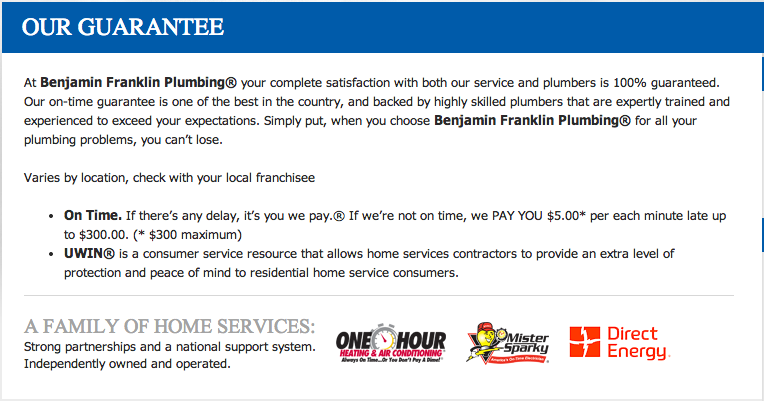There’s a game of tug of war going on in your prospects’ minds.
It happens every time someone lands on your website. Skepticism and doubt pull the rope in one direction. Compelling headlines, testimonials, and benefit-packed sales copy pull it the other way.
People want to believe your product or service can create the results you say it can. They want to take action and do business with someone they can trust.
But they’re stuck. They’ve seen too many shoddy businesses online. Many of them have been burned in the past. The doubt swirling in their minds keeps them from taking action.
How can you break this deadlock and convince more visitors to become buyers?
By strategically removing visitors’ perceived risk of doing business with you.

Photo Credit: Ageless North Shore via Compfight cc
The Challenge: Widespread Consumer Skepticism
Easing visitors’ perceived risks of doing business with you is an uphill battle.
Increased competition and a barrage of advertising have raised the stakes. Attention is quickly becoming a prized commodity, with plenty of businesses willing to pour huge marketing budgets to get it.
Scammers and rip-off artists have also poisoned the well for honest businesses, leading to increased consumer skepticism across the board. In a 2007 Florida State University study, researchers tested the effect of salespeople’s flattery at different points during the sales process. The customers, shoppers browsing a mall kiosk selling sunglasses, didn’t trust the salespeople’s words at any time – even when the salesperson waited to flatter them until after they’d purchased a pair of sunglasses.
Things are even tougher online. Prospects can’t meet you in person to judge your credibility. And they can’t experience your products or services in a way they could at a physical store. All they have to go on is the information you share with them.
Overcoming Visitors’ Perceived Risk of Doing Business with You
Overcoming visitors’ sense of risk is fundamental to hitting conversion goals and growing your business.
Even if your copy does a great job showcasing your product or service and how it could help visitors, many won’t take the leap to become customers unless you strip away the risk.
Doubt – even a flicker of it – leads to hesitation. And hesitation leads to missed opportunities.
Here’s an unfortunate reality of operating in the same space as scammers and identity thieves. Even if your sales copy does everything right and primes visitors to buy, their natural reaction is to think your offer is “too good to be true.”
Risk removal is the pinch on the cheek visitors need to see they aren’t dreaming – that the solution they’re looking for is right in front of them. And they’re in safe hands with your business providing it.
4 Risk Removal Best Practices
The most effective way to overcome visitor skepticism and doubt is to attack it on two fronts:
- Boost your credibility with trust signals; and
- Minimize your target customers’ perceived risk.
This post focuses on the risk removal variable. For information about boosting credibility online and tips on how to do it, check out our guide to improve conversion rates with trust signals.
Now, how do we decrease perceived risk and get more customers to buy?
Here are four risk removal best practices to keep in mind:
1. Identify Which Risk to Focus on
A common mistake businesses make is focusing 100% of their risk removal efforts on easing visitors’ sense of financial risk.
The thought of losing money is an issue with every potential business transaction, but it might not be the primary source of visitors’ concerns. Focusing on money to the exclusion of other types of risks leads to missed opportunities.
There are countless other things to worry about. Wasted time. Frustration. Looking silly in front of others if a product or service doesn’t work (that’s a big one).
The most successful risk removal strategies are built to overcome visitors’ greatest source of anxiety. What is the biggest obstacle keeping visitors from becoming customers? If you don’t have a clue, you can solicit feedback through surveys and direct outreach.
Considering more than financial risk – and honing in on your customers’ greatest concern – will give you the insights you need to overcome it.
That’s what Benjamin Franklin Plumbing (the “Punctual Plumber”) did. They identified a common barrier that kept people from hiring them – not wanting to wait around for a plumber to show up – and guaranteed to pay customers $5 for every minute they were late to an appointment.

Image Credit: Benjamin Franklin Plumbing
2. Tip the Risk Balance in the Customers’ Favor
In a typical buying-selling transaction, the buyer is usually the one who bears the risk. Risk of lost time, hassles with returning faulty products, and of course financial risk. This is doubly true with online transactions because buyers are unable to meet sellers in person or investigate what they’re selling.
Risk removal strategies (usually guarantees) work to balance the risk and make things fairer. But you can take this even further; you can actually tip the risk in your potential customers’ favor!
By using a guarantee to shoulder the transaction risk, you show a lot of confidence in your product or service. You make it simple for people to overcome their doubts and buy from you. It’s easier to justify action when they don’t have anything to lose.
Michael Fortin, one of the most successful copywriters around, found that risk reversal was a common element in successful sales copy. And this held true in almost every industry he worked in.
Aldi, a grocery store, is employing risk reversal to reassure potential customers and drive sales. Their “double guarantee” assures shoppers that Aldi will replace unsatisfactory products and refund the customers’ money. This takes the risk off the customers’ shoulders and makes it easy for them to shop with confidence.

Image Credit: Aldi
3. Watch out for Too Much Hype
Ironically, creating a really strong guarantee – and failing to explain or justify it adequately – can actually increase visitors’ perceived risk of doing business with you.
Guarantees that seem ridiculously strong (especially ones that last for years or a lifetime) can unconsciously convey an image of weakness. People wonder if you’re trying to make up for a low-quality product by building the perceived value with your guarantee instead.
Strong guarantees can and do work well within the proper context. The easiest way to create that context for visitors is to explain why you’re willing to go to such lengths to include a powerful guarantee.
The key is to strike a balance between the strongest guarantee possible and something that doesn’t venture into “too good to be true” land. Take a look how Briggs & Riley does this in their “Simple as That” lifetime guarantee to repair damaged luggage. They explain that their strong guarantee is more than a marketing strategy; it’s a reflection of their integrity.

Image Credit: Brigs & Riley
4. Prominent Display and Strategic Placement
As much as you’d like them to, your visitors probably won’t read your sales pages from beginning to end. They won’t watch your videos all the way through. It’s just the way people browse online.
Poor placement of your guarantee decreases the chances of visitors seeing it. And when they don’t see it, their perceived risk of buying remains.
Tacking on a guarantee towards the end of content is common, but it isn’t necessarily the best way to expose it to as many viewers as possible.
Another issue is “hiding” your guarantee. Tucking it in a corner of a web page or using tiny font creates suspicions that your guarantee is weak, you’re trying to scam people, or both.
Brands with strong guarantees aren’t afraid to introduce them at an earlier point in the sales process. Some, like fitness products promising certain results or your money back, go as far as to tie their guarantee into their headlines – the first thing users experience.
Don’t be afraid to display your guarantee prominently or experiment with placement. You might be able to remove the perceived risk early on, hooking visitors to engage with the rest of your copy.
Instead of burying its best price guarantee on an interior web page, Expedia draws attention to it by placing it above the fold on its homepage.

Image Credit: Expedia
Tying It All Together
Risk removal is an essential component in the selling process.
Most businesses understand this on a basic level. But they don’t get as many conversions as they could because they don’t give risk removal nearly as much attention as headlines, calls to action, and other elements.
These best practices will get you moving in the right direction. But the only way to optimize your risk-removal for conversions is through experimentation and testing.
It’s time to give risk removal the attention it deserves and incorporate it within a broader CRO strategy. Through testing and optimization, you can streamline your guarantees to build trust and win more customers.
How are you handling risk removal in your business right now? What’s something you think you could try to do it even better? Leave a comment below and let us know!






